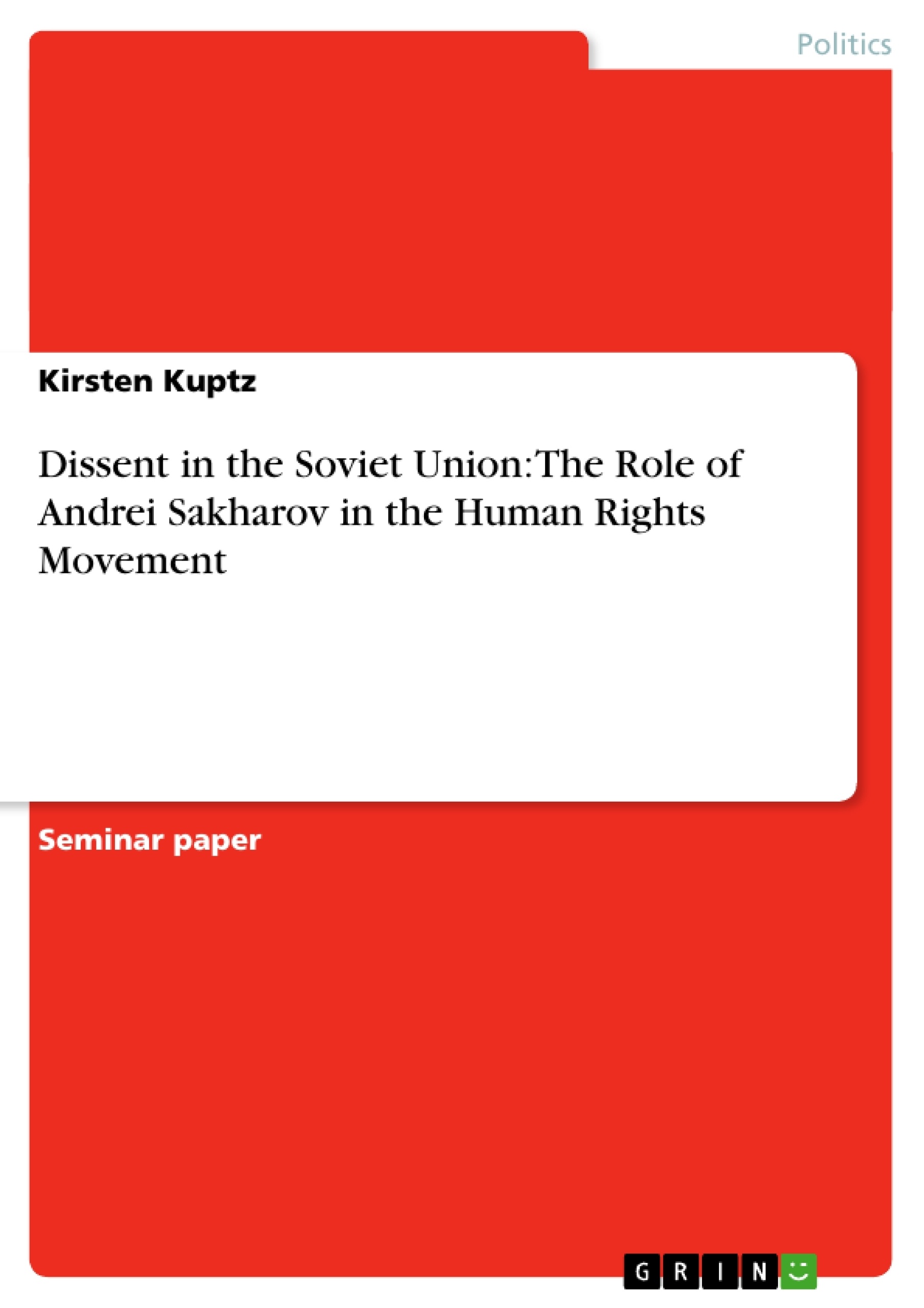‘Other civilizations, including more "successful" ones, should exist an infinite number of times on the "preceding" and the "following" pages of the Book of the Universe. Yet this should not minimize our sacred endeavors in this world of ours, where, like faint glimmers of light in the dark, we have emerged for a moment from the nothingness of dark unconsciousness of material existence. We must make good the demands of reason and create a life worthy of ourselves and of the goals we only dimly perceive.’ (From the Nobel Lecture of Andrei Sakharov, 1975)
Dissent in the Soviet Union was not well known: neither in the West nor in Soviet society itself. Prior to the end of total terror with the death of Stalin in 1953, dissent in the Soviet Union could not be expressed publicly. In his first years in power, Khrushchev tolerated a certain degree of free discussion and even released some political prisoners. Soon, however, the ‘refreezing of the thaw’ began, especially under Brezhnev; critics became too outspoken, and demands for free expression exceeded ‘acceptable limits’. The Communist Party regained absolute control over the flow of information and ideas, and over all kinds of literature. Yet despite the ideological penetration and strict surveillance of society through the authorities and the KGB in particular, some people were able to fight for their rights and for a rival vision of freedom and justice.
It is debatable whether the term ‘movement’ can be appropriately applied to dissent in the Soviet Union since it lacked any organizational structure or formal program. That said, the term is commonly used to describe the group of people, emerging in the early 1960s, who raised their voice against policies of the regime.
Soon, the physicist Andrei Sakharov was considered to represent the spirit of the movement: ‘he embodies the human rights movement in his own person: self-sacrifice, a willingness to help persons […] who are illegally prosecuted; intellectual tolerance, unwavering insistence on the rights and dignity of the individual, and an aversion to lies and to all forms of violence (Alexeyeva 1985: 332).’ A father of the Soviet hydrogen-bomb,
Sakharov’s life came to a radical turning-point when his interest shifted from physics - which had placed him among the elite of Soviet society - to politics - which converted him into a nonconformist and Nobel Peace Prize laureate. [...]
Inhaltsverzeichnis (Table of Contents)
- Introduction
- Dissent in the Soviet Union
- The Human Rights Movement
- Andrei Sakharov's 'First Life': 1921-1965
- Andrei Sakharov's 'Second Life': 1966-1979
- Andrei Sakharov in Exile: 1980-1986
- Andrei Sakharov Back in Moscow: 1987-1989
- Conclusion
Zielsetzung und Themenschwerpunkte (Objectives and Key Themes)
This paper aims to shed light on the crucial role Andrei Sakharov played in the human rights movement in the Soviet Union. By exploring his life and activities as a dissident, the paper provides insights into the history of the Soviet Union itself.
- The nature and evolution of dissent in the Soviet Union.
- The development and characteristics of the human rights movement.
- The life and career of Andrei Sakharov as a prominent figure in the movement.
- The impact of Sakharov's actions on the Soviet political landscape.
- The challenges faced by dissidents in the Soviet Union.
Zusammenfassung der Kapitel (Chapter Summaries)
- Introduction: This chapter introduces the concept of dissent in the Soviet Union and highlights the unique circumstances under which it emerged. The chapter also emphasizes the importance of Andrei Sakharov's contributions to the human rights movement.
- Dissent in the Soviet Union: This chapter examines the nature of dissent in the Soviet Union, highlighting its lack of formal organization and structure. The chapter also explores the historical context of dissent, including the repressive policies of the Soviet regime.
- The Human Rights Movement: This chapter delves into the emergence and evolution of the human rights movement in the Soviet Union. The chapter explores the motivations and methods of individuals who actively protested against the regime's policies.
- Andrei Sakharov's 'First Life': 1921-1965: This chapter traces the early life and career of Andrei Sakharov, highlighting his achievements as a prominent physicist and his initial involvement in the Soviet scientific establishment.
- Andrei Sakharov's 'Second Life': 1966-1979: This chapter explores the period when Sakharov transitioned from a renowned scientist to a prominent dissident. The chapter examines his growing concern for human rights and his increasing opposition to the Soviet regime.
- Andrei Sakharov in Exile: 1980-1986: This chapter focuses on Sakharov's exile from Moscow, highlighting the Soviet government's attempts to silence his dissent. The chapter also examines Sakharov's continued advocacy for human rights despite his forced relocation.
Schlüsselwörter (Keywords)
Key concepts and themes explored in this paper include dissent, human rights, the Soviet Union, political repression, freedom of speech, the KGB, the Communist Party, intellectual dissent, the Nobel Peace Prize, Andrei Sakharov, and the history of the Soviet Union.
- Citar trabajo
- Kirsten Kuptz (Autor), 2004, Dissent in the Soviet Union: The Role of Andrei Sakharov in the Human Rights Movement, Múnich, GRIN Verlag, https://www.grin.com/document/25109



